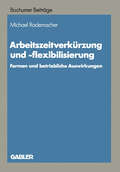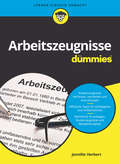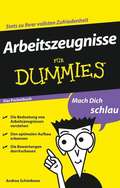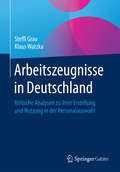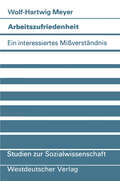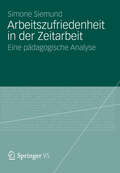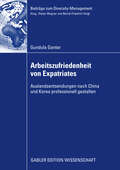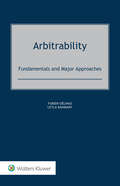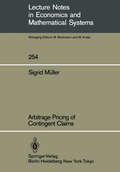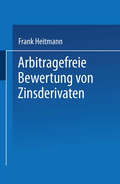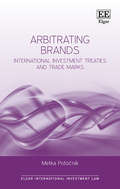- Table View
- List View
Arbeitszeitmodelle im ärztlichen Dienst: Auswirkungen auf die Mitarbeiterzufriedenheit und die Hospital Performance Outcomes (Marktorientiertes Nonprofit-Management)
by Kirstin TrothaAuf Basis einer empirischen Datenanalyse von Krankenhausärzten, Patienten und Managern aus Krankenhäusern untersucht Kirstin von Trotha ob und in welchem Maße die Zufriedenheit der Ärzte durch die verschiedenen Arbeitszeitmodelle beeinflusst wird und sich diese wiederum auf das strategische Ziel der Wettbewerbsfähigkeit und sich somit auf den Krankenhauserfolg auswirkt. Darüber hinaus gibt sie Handlungsempfehlungen zur Einführung von neuen Arbeitszeitmodellen in Krankenhäusern.
Arbeitszeitpolitik: Zielkonflikte in der betrieblichen Arbeitszeitgestaltung lösen (IBE-Reihe)
by Jutta Rump Silke EilersDieses Buch beschäftigt sich umfassend mit der Frage, worin zentrale Arbeitszeitkonflikte liegen, bei denen die Bedürfnisse des Arbeitgebers und des Arbeitnehmenden auf den ersten Blick nur schwer vereinbar erscheinen. Zahlreiche Beispiele von Expertinnen und Experten aus der Wissenschaft sowie aus Betrieben und Organisationen geben Einblick in die Arbeitszeitpraxis in deutschen Unternehmen und Verwaltungen und erläutern umsetzbare Lösungsansätze. Das Buch verdeutlicht anschaulich die unterschiedlichen Perspektiven, auch aus der Sicht der Sozialpartner, zeigt Lösungsansätze auf, wie sich Arbeitszeitkonflikte entschärfen lassen und schlägt somit die Brücke zwischen theoretischen Wissen und praxisnaher Anwendung. Acht Themenschwerpunkte rund um betriebliche Arbeitszeitgestaltung geben Einblick in aktuelle Trends und Entwicklungen:- Unternehmensführung vor dem Hintergrund des Zielkonflikts in der Zeitpolitik - Langzeitkonten - Arbeitszeitprojekte in Betrieben und Verwaltungen beteiligungsorientiert gestalten- Mobile Arbeit - Mehr Zeitsouveränität durch Arbeitszeitkonten- Schichtarbeit unter demografischen Herausforderungen- Wiedereinführung eines Zeiterfassungssystems - Arbeitszeit in Deutschland: Länge, Lage, Flexibilität der Arbeitszeit und die Gesundheit der Beschäftigten
Arbeitszeitstudien an Haushaltbottichwaschmaschinen gleicher Art und Größe mit verschiedener Ausstattung (Forschungsberichte des Landes Nordrhein-Westfalen #826)
by Eva SchmahlArbeitszeitstudien an Haushaltswaschmaschinen (Forschungsberichte des Wirtschafts- und Verkehrsministeriums Nordrhein-Westfalen #62)
by Oswald ViertelArbeitszeitverkürzung und -flexibilisierung: Formen und betriebliche Auswirkungen (Bochumer Beiträge zur Unternehmensführung und Unternehmensforschung #36)
by Michael RademacherArbeitszeugnisse aus personalpolitischer Perspektive: Gestaltung, Einsatz und Wahrnehmungen (Betriebliche Personalpolitik)
by Monika HuesmannAuf der Grundlage einer umfassenden empirischen Studie, in der die Autorin verschiedene Personengruppen zu Gestaltung und Inhalt von Arbeitszeugnissen befragt und Arbeitszeugnisse analysiert, erforscht sie das Diskriminierungspotenzial mit Bezug auf das Allgemeine Gleichbehandlungsgesetz und gibt Implikationen für die Unternehmenspraxis.
Arbeitszeugnisse für Dummies (Für Dummies)
by Jennifer Herbert"Sehr gesellig und ideenreich". Klingt doch eigentlich nett, aber eine solche Formulierung in einem Arbeitszeugnis ist eine Katastrophe, denn sie bescheinigt erheblichen Alkoholkonsum und den Widerwillen, sich an Regeln zu halten. Es ist nicht einfach, die Sprache von Arbeitszeugnissen zu entschlüsseln. Jennifer Herbert zeigt Arbeitgebern, wie sie Stolperfallen umgehen und ein korrektes Arbeitszeugnis erstellen, und Arbeitnehmern, wie sie es analysieren können. Sie geht auf Aufbau und Inhalt eines Zeugnisses ein und erläutert anhand von Musterzeugnissen, welche Noten hinter welchen Formulierungen stecken. So erscheint die Zeugnissprache nicht mehr ganz so rätselhaft.
Arbeitszeugnisse für Dummies Das Pocketbuch (Für Dummies)
by Andrea Schimbeno"Stets pünktlich und adrett gekleidet." Was bedeutet das in einem Zeugnis? Andrea Schimbeno weiht Sie nicht nur in die Geheimsprache der Arbeitszeugnisse ein, Sie erklärt Ihnen auch, was ein "einfaches" von einem "qualifizierten" Zeugnis unterscheidet. Was darf drinstehen und was nicht? Was bedeutet die Forderung des Gesetzgebers, dass ein Arbeitszeugnis "wohlwollend" formuliert sein muss? Und welche Fristen müssen eingehalten werden? Ob Sie ein Arbeitszeugnis erhalten oder eines schreiben müssen - es gibt viel zu beachten. Hier erfahren Sie, worauf Sie achten müssen. Stimmt die Form? Wurden alle wichtigen Punkte berücksichtig? Als Arbeitnehmer begleitet Sie ein Arbeitszeugnis durch Ihr weiteres Berufsleben, als Arbeitgeber können Sie für falsche Angaben haftbar gemacht werden. Da lohnt es sich, sich schlau zu machen.
Arbeitszeugnisse in Deutschland: Kritische Analysen zu ihrer Erstellung und Nutzung in der Personalauswahl
by Steffi Grau Klaus WatzkaDieses Werk bietet auf Basis einer kritischen Analyse der derzeitigen Zeugnispraxis aktuelle empirische Forschungsergebnisse zum Thema Arbeitszeugnisse. Sie zeigen dringenden Verbesserungsbedarf an. Die Autoren präsentieren daher ein breites Spektrum konkreter und praxisnaher Handlungsempfehlungen für Personalverantwortliche und Unternehmen sowie den Gesetzgeber. Ausführlich zeigen die Verfasser, wie die Qualität und Präzision und damit der Nutzen von Arbeitszeugnissen für die Personalauswahl gesteigert werden kann.
Arbeitszufriedenheit: Ein interessiertes Mißverständnis (Studien zur Sozialwissenschaft #53)
by Wolf-Hartwig MeyerArbeitszufriedenheit in der Zeitarbeit: Eine pädagogische Analyse
by Simone SiemundWie empfinden Zeitarbeitskräfte ihre tägliche Arbeit? Welche Ziele verfolgen sie? Was macht sie trotz des hohen prekären Potenzials von Zeitarbeit zufrieden?In einer qualitativen Studie untersucht Simone Siemund Arbeitszufriedenheit und -motivation bei Zeitarbeitskräften. Die Autorin beschreibt Wirkungen prekärer Beschäftigungsverhältnisse und macht deutlich, welchen spezifischen Belastungen Beschäftigte in der Zeitarbeit ausgesetzt sind. Aufgrund des pädagogischen Blickwinkels rücken dabei die Erwerbsbiographien der befragten Personen ebenso in den Fokus wie berufliche Kompetenzentwicklung und Lernen. Zitate aus zahlreichen Interviews ermöglichen Einblicke in die Branche aus Sicht der Beschäftigten.
Arbeitszufriedenheit von Expatriates: Auslandsentsendungen nach China und Korea professionell gestalten (Beiträge zum Diversity Management)
by Gundula GanterGundula Ganter stellt aktuelle Forschungsergebnisse und Lösungsansätze für ein professionelles Expatriate Management vor. Sie identifiziert auf Basis einer qualitativen und quantitativen Befragung die Hauptursachen für Unzufriedenheit und leitet konkrete Handlungsempfehlungen für die strategische Ausrichtung der Entsendepraxis sowie für das Management ausländischer Tochtergesellschaften ab.
Arbitrability: Fundamentals and Major Approaches
by Fabien Gélinas Leyla BahmanyAs simple as the arbitrability question might appear (namely, what types of issues may and may not be submitted to arbitration), for a legal system to set a clear and consistent approach to arbitration, it must consider many complicated factors that relate to public policy and economic priorities as well as international relations. This comprehensive, precise, and practical book identifies and analyzes the fundamentals of, and major approaches to, arbitrability in the current international context. The authors focus on nine major arbitration jurisdictions—the United States, Canada, France, England and Wales, Switzerland, Germany, China (Mainland), Hong Kong, and Singapore—with meticulous attention to each jurisdiction’s pertinent case law and legislative framework as well as relevant commentary. For each jurisdiction, the arbitrability of disputes in the following fields of law is discussed: antitrust/competition; bankruptcy/insolvency; consumer; corporate; family/domestic relations; intellectual property (copyright, patent, and trademark); labor/employment; securities; and torts. Based on the jurisdiction-by-jurisdiction analysis, the authors identify key areas in which the selected jurisdictions share similarities and evince differences with respect to each of the above-mentioned fields. With a structure that enables readers to easily locate what they are looking for and gives clear-cut answers, this unique book fully elucidates the notion of arbitrability by identifying the key concepts, the applicable rules, and different criteria for arbitrability and by explaining how different jurisdictions deal with specific types of disputes. It will be welcomed by counsel, arbitrators, judges, students, and academics active in international arbitration and the enforcement of arbitral awards.
Arbitrage: Elements of Financial Economics
by Michael G. AllinghamA text using the concept of arbitrage to value securities, that is to construct the elements of financial economics. Divided into three parts, the book develops the foundations for the study, applies the basic theorem in a single-period setting and extends the discussion to a many-period setting.
An Arbitrage Guide to Financial Markets (The Wiley Finance Series #453)
by Robert DubilAn Arbitrage Guide to Financial Markets is the first book to explicitly show the linkages of markets for equities, currencies, fixed income and commodities. Using a unique structural approach, it dissects all markets the same way: into spot, forward and contingent dimensions, bringing out the simplicity and the commonalities of all markets. The book shuns stochastic calculus in favor of cash flow details of arbitrage trades. All math is simple, but there is lots of it. The book reflects the relative value mentality of an institutional trader seeking profit from misalignments of various market segments. The book is aimed at entrants into investment banking and dealing businesses, existing personnel in non-trading jobs, and people outside of the financial services industry trying to gain a view into what drives dealers in today’s highly integrated marketplace. A committed reader is guaranteed to leave with a deep understanding of all current issues. "This is an excellent introduction to the financial markets by an author with a strong academic approach and practical insights from trading experience. At a time when the proliferation of financial instruments and the increased use of sophisticated mathematics in their analysis, makes an introduction to financial markets intimidating to most, this book is very useful. It provides an insight into the core concepts across markets and uses mathematics at an accessible level. It equips readers to understand the fundamentals of markets, valuation and trading. I would highly recommend it to anyone looking to understand the essentials of successfully trading, structuring or using the entire range of financial instruments available today." —Varun Gosain, Principal, Constellation Capital Management, New York "Robert Dubil, drawing from his extensive prior trading experience, has made a significant contribution by writing an easy to understand book about the complex world of today’s financial markets, using basic mathematical concepts. The book is filled with insights and real life examples about how traders approach the market and is required reading for anyone with an interest in understanding markets or a career in trading." —George Handjinicolaou, Partner, Etolian Capital, New York "This book provides an excellent guide to the current state of the financial markets. It combines academic rigour with the author’s practical experience of the financial sector, giving both students and practitioners an insight into the arbitrage pricing mechanism." —Zenji Nakamura, Managing Director, Europe Fixed Income Division, Nomura International plc, London
Arbitrage, Hedging, and Speculation: The Foreign Exchange Market (Non-ser.)
by Ephraim Clark Dilip K. GhoshExplains arbitrage, hedging, and speculation from the standpoint of a participant in the foreign exchange market—whether an individual trader or an institutional trader—who possesses analytical skill, economically sound judgment, and who has access to market data. In the foreign exchange market, arbitrage involves the simultaneous purchase and sale of a currency in different markets; the profit comes from the difference in the buying and selling prices. Hedging and speculation are opposing strategies for dealing with risk; hedging is a cover, and speculation is an assumption of risk. Authors also discuss futures, swaps, forward contracts, and other strategies. For financial scholars, students, analysts, and currency traders.
Arbitrage Pricing of Contingent Claims (Lecture Notes in Economics and Mathematical Systems #254)
by Sigrid MüllerArbitrage Theory: Introductory Lectures on Arbitrage-Based Financial Asset Pricing (Lecture Notes in Economics and Mathematical Systems #245)
by Jochen E.M. WilhelmThe present 'Introductory Lectures on Arbitrage-based Financial Asset Pricing' are a first attempt to give a comprehensive presentation of Arbitrage Theory in a discrete time framework (by the way: all the re sults given in these lectures apply to a continuous time framework but, probably, in continuous time we could achieve stronger results - of course at the price of stronger assumptions). It has been turned out in the last few years that capital market theory as derived and evolved from the capital asset pricing model (CAPM) in the middle sixties, can, to an astonishing extent, be based on arbitrage arguments only, rather than on mean-variance preferences of investors. On the other hand, ar bitrage arguments provided access to a wider range of results which could not be obtained by standard CAPM-methods, e. g. the valuation of contingent claims (derivative assets) Dr the_ investigation of futures prices. To some extent the presentation will loosely follow historical lines. A selected set of capital asset pricing models will be derived according to their historical progress and their increasing complexity as well. It will be seen that they all share common structural properties. After having made this observation the presentation will become an axiomatical one: it will be stated in precise terms what arbitrage is about and what the consequences are if markets do not allow for risk-free arbitrage opportunities. The presentation will partly be accompanied by an illus trating example: two-state option pricing.
Arbitrage Theory in Continuous Time (Oxford Finance Series)
by Tomas BjörkThe fourth edition of this widely used textbook on pricing and hedging of financial derivatives now also includes dynamic equilibrium theory and continues to combine sound mathematical principles with economic applications. Concentrating on the probabilistic theory of continuous time arbitrage pricing of financial derivatives, including stochastic optimal control theory and optimal stopping theory, Arbitrage Theory in Continuous Time is designed for graduate students in economics and mathematics, and combines the necessary mathematical background with a solid economic focus. It includes a solved example for every new technique presented, contains numerous exercises, and suggests further reading in each chapter. All concepts and ideas are discussed, not only from a mathematics point of view, but with lots of intuitive economic arguments. In the substantially extended fourth edition Tomas Björk has added completely new chapters on incomplete markets, treating such topics as the Esscher transform, the minimal martingale measure, f-divergences, optimal investment theory for incomplete markets, and good deal bounds. This edition includes an entirely new section presenting dynamic equilibrium theory, covering unit net supply endowments models and the Cox-Ingersoll-Ross equilibrium factor model. Providing two full treatments of arbitrage theory-the classical delta hedging approach and the modern martingale approach-this book is written so that these approaches can be studied independently of each other, thus providing the less mathematically-oriented reader with a self-contained introduction to arbitrage theory and equilibrium theory, while at the same time allowing the more advanced student to see the full theory in action. This textbook is a natural choice for graduate students and advanced undergraduates studying finance and an invaluable introduction to mathematical finance for mathematicians and professionals in the market.
Arbitrage Theory in Continuous Time (Oxford Finance Series)
by Tomas BjörkThe fourth edition of this widely used textbook on pricing and hedging of financial derivatives now also includes dynamic equilibrium theory and continues to combine sound mathematical principles with economic applications. Concentrating on the probabilistic theory of continuous time arbitrage pricing of financial derivatives, including stochastic optimal control theory and optimal stopping theory, Arbitrage Theory in Continuous Time is designed for graduate students in economics and mathematics, and combines the necessary mathematical background with a solid economic focus. It includes a solved example for every new technique presented, contains numerous exercises, and suggests further reading in each chapter. All concepts and ideas are discussed, not only from a mathematics point of view, but with lots of intuitive economic arguments. In the substantially extended fourth edition Tomas Björk has added completely new chapters on incomplete markets, treating such topics as the Esscher transform, the minimal martingale measure, f-divergences, optimal investment theory for incomplete markets, and good deal bounds. This edition includes an entirely new section presenting dynamic equilibrium theory, covering unit net supply endowments models and the Cox-Ingersoll-Ross equilibrium factor model. Providing two full treatments of arbitrage theory-the classical delta hedging approach and the modern martingale approach-this book is written so that these approaches can be studied independently of each other, thus providing the less mathematically-oriented reader with a self-contained introduction to arbitrage theory and equilibrium theory, while at the same time allowing the more advanced student to see the full theory in action. This textbook is a natural choice for graduate students and advanced undergraduates studying finance and an invaluable introduction to mathematical finance for mathematicians and professionals in the market.
Arbitrage und die Bewertung von Zinssatzoptionen (Wirtschaftswissenschaftliche Beiträge #52)
by Klaus SandmannArbitragefreie Bewertung von Zinsderivaten
by Frank HeitmannDas in dieser Arbeit entwickelte Modell ist in der Lage, die historisch festgestellten Shifts, Reversionen und Twists der Zinsstruktur zu erklären und bestätigt sich bei Tests mit deutschen Zinsoptionsscheinen.
Arbitrating Brands: International Investment Treaties and Trade Marks (Elgar International Investment Law series)
by Metka PotočnikBrand recognition is crucial to companies promoting the sale of products and services. Directors invest considerable revenue into developing brand imagery that is unique and identifiable. Linking intellectual property law and international investment law, Arbitrating Brands takes the opportunity to analyse trade marks and brands as examples of foreign direct investment. In light of the Phillip Morris cases against Australia and Uruguay, Metka Potočnik explores the substantive protection of trade marks under international investment treaties, unpacking the specifics of arbitrating investment claims arising out of state trade mark regulation. Utilising plain packaging regulation for tobacco products as a springboard for analysis, this book offers a practical approach with recommendations for arbitrators on how to approach trade mark investment cases. Detailed and insightful, this book is essential reading for arbitration practitioners, offering practical analytical tools to approaching the adjudication of trade mark investment disputes. It will also be of interest to the growing group of researchers and students focusing on intellectual property arbitration. Furthermore, brand owners following developments in the field will benefit from this book’s insight into the trajectories of trade mark legislation.






